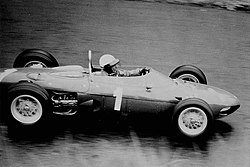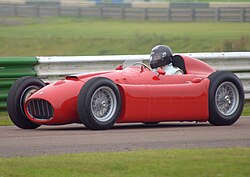Ferrari 156 F1
 | |||||||||
| Category | Formula One | ||||||||
|---|---|---|---|---|---|---|---|---|---|
| Constructor | Ferrari | ||||||||
| Designer(s) | Carlo Chiti | ||||||||
| Predecessor | 246 F1 | ||||||||
| Successor | 158 | ||||||||
| Technical specifications | |||||||||
| Chassis | Tubular Spaceframe | ||||||||
| Engine | Ferrari Dino Type 156, 1,496 cc (91.3 cu in), 120° V6 2 valves per cylinder DOHC, naturally aspiratedMid-engined, longitudinally mounted | ||||||||
| Transmission | Ferrari Type 543/C 5-speed manual | ||||||||
| Fuel | Shell | ||||||||
| Tyres | Dunlop | ||||||||
| Competition history | |||||||||
| Notable entrants | Scuderia Ferrari FISA Scuderia Sant Ambroeus | ||||||||
| Notable drivers | |||||||||
| Debut | 1961 Monaco Grand Prix | ||||||||
| |||||||||
| Constructors' Championships | 1 (1961) | ||||||||
| Drivers' Championships | 1 (1961 - Phil Hill) | ||||||||
| n.b. Unless otherwise stated, all data refer to Formula One World Championship Grands Prix only. | |||||||||
The Ferrari 156 was a racecar made by Ferrari in 1961 to comply with then-new F1 regulations that lowered engine displacement from 2.5 to 1.5 litres, similar to the pre-1961 F2 class for which Ferrari had developed a mid-engined car also called 156. It used the V6 "Dino" engine named after Enzo Ferrari's late son.
The new engine was a revised F2 engine with the V-angle increased from 65 to 120 degrees. This increased the power by 10 hp (7 kW). Bore and stoke were 73.0 x 58.8 mm (2.3 in) with a displacement of 1,476.60 cc and a claimed 190 hp (142 kW) at 9,500 rpm. For 1962 a 24-valve version was planned with 200 hp (149 kW) at 10,000 rpm, but never appeared. In 1963 the 12-valve version fitted with Bosch direct-fuel injection instead of carburetors achieved that power level. The last victory for the Ferrari 156 was achieved by Italian Lorenzo Bandini in the 1964 Austrian Grand Prix.
A V-6 engine with 120 degree bank is smoother at producing power because every 120 degree rotation of engine crankshaft produces a power pulse.
It is one of the most iconic racecar shapes and one of the most distinctive of all Ferraris.Phil Hill won the 1961 World Championship of Drivers and Ferrari secured the 1961 International Cup for F1 Manufacturers, both victories achieved with the 156.
Sharknose
The 1961 version was affectionately dubbed "sharknose" due to its characteristic air intake "nostrils". Unfortunately, then-Ferrari factory policy inevitably saw all the remaining sharknose 156s scrapped by the end of the 1963 season. Nevertheless such an F 156 is exhibited in the "Galleria Ferrari, at Maranello, probably a replica. A similar intake duct styling was applied over forty years later to the Ferrari F430.
1963 Ferrari 156 Aero
The updated Ferrari 156, used in the 1963 season, did not feature the distinctive sharknose design. but had a rather conventional intake, somewhat larger than the Ferrari 158 introduced in 1964.
Monza crash
On September 10, 1961, after a collision with Jim Clark's Lotus on the second lap of the Italian Grand Prix, the 156 of Wolfgang von Trips (Hill's teammate) became airborne and crashed into a side barrier, fatally throwing him from the car and killing fifteen spectators.
Famous drivers
- Phil Hill
- Wolfgang Graf Berghe von Trips
- Richie Ginther
- Willy Mairesse
- Giancarlo Baghetti
- Ricardo Rodríguez
- Lorenzo Bandini
- Innes Ireland
- Olivier Gendebien
In popular culture
- English Blues singer-songwriter Chris Rea had a meticulous replica of the sharknose built for him to use in his 1996 film, La Passione.
Complete Formula One World Championship results
(key) (results in bold indicate pole position; results in italics indicate fastest lap)
| Year | Entrant | Engine | Tyres | Drivers | 1 | 2 | 3 | 4 | 5 | 6 | 7 | 8 | 9 | 10 | Points | WCC |
|---|---|---|---|---|---|---|---|---|---|---|---|---|---|---|---|---|
| 1961 | Scuderia Ferrari SpA SEFAC | Ferrari 178 1.5V6 | D | MON | NED | BEL | FRA | GBR | GER | ITA | USA | 40 (52) | 1st | |||
| 2 | 5 | 3 | 15 | 3 | 8 | Ret | WD | |||||||||
| 3 | 2 | 1 | 9 | 2 | 3 | 1 | WD | |||||||||
| 4 | 1 | 2 | Ret | 1 | 2 | Ret | ||||||||||
| 4 | ||||||||||||||||
| Ret | ||||||||||||||||
| Ret | WD | |||||||||||||||
| FISA | 1 | |||||||||||||||
| Scuderia Sant Ambroeus | Ret | Ret | ||||||||||||||
| 1962 | Scuderia Ferrari SpA SEFAC | Ferrari 178 1.5 V6 | D | NED | MON | BEL | FRA | GBR | GER | ITA | USA | RSA | 18 | 6th | ||
| 3 | 2 | 3 | WD | Ret | Ret | 11 | ||||||||||
| 4 | Ret | WD | 10 | 5 | WD | |||||||||||
| Ret | 4 | WD | WD | 6 | 14 | |||||||||||
| 3 | WD | Ret | 8 | WD | ||||||||||||
| 7 | Ret | 4 | WD | |||||||||||||
| 1963 | Scuderia Ferrari SpA SEFAC | Ferrari 178 1.5V6 | D | MON | BEL | NED | FRA | GBR | GER | ITA | USA | MEX | RSA | 26 | 4th | |
| Ret | Ret | Ret | ||||||||||||||
| 4 | Ret | 3 | Ret | 2 | 1 | Ret | 9 | DSQ | Ret | |||||||
| WD | 6 | DNS | ||||||||||||||
| Ret | 5 | Ret | 5 | |||||||||||||
| 1964 | Scuderia Ferrari SpA SEFAC | Ferrari 178 1.5V6 | D | MON | NED | BEL | FRA | GBR | GER | AUT | ITA | USA | MEX | 45 (49) | 1st | |
| 10 | 5 | 3 | 1 | |||||||||||||
| 9 | ||||||||||||||||
| North American Racing Team | 6 |











![Validate my RSS feed [Valid RSS]](valid-rss-rogers.png)














































































